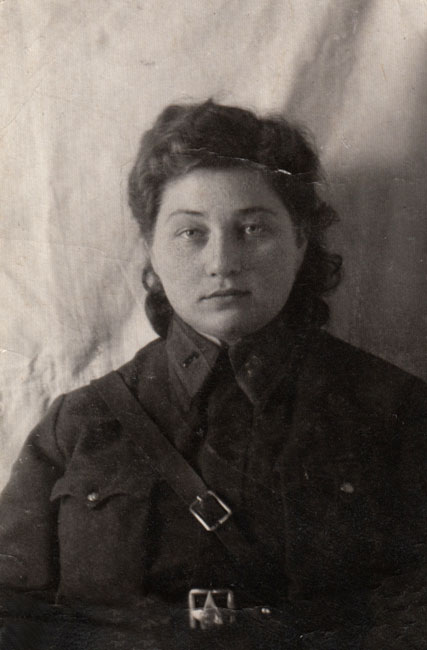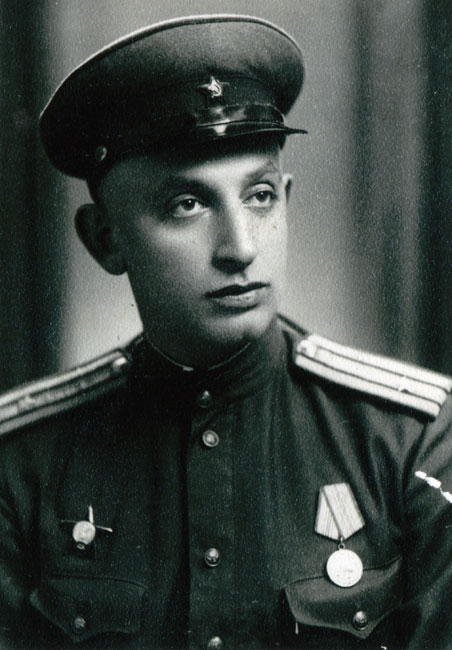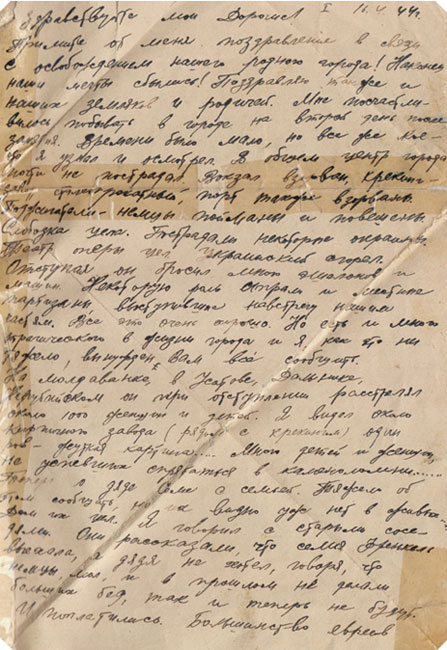Miriam Kogan was born in 1919 in Odessa, Ukraine. On June 27, 1941, five days after the outbreak of the war between the Soviet Union and Nazi Germany, Miriam passed her final exam at the Odessa Medical Institute and on July 2 volunteered to join the Red Army. She served in the field medical service and afterwards was assigned to be a commander of a medical regiment of an infantry division, providing emergency care in close proximity to the front lines. In an interview she gave in 2009 in Odessa to The Blavatnik Archive Foundation Miriam Kogan recalled her service as a young military doctor on the battlefield:
"… I was with my friend Zhenia Lerner, we were the two doctors in our regiment's medical unit and we worked non-stop. We set up our small medical stations for hour or hour and a half time periods and administered emergency care that our regiment needed.… Like when we were positioned within 20-30 meters from a battlefield. We set up in any possible location, once even in a blacksmith shop. There was a blacksmith shop, we covered the inside with sheets, wounded soldiers were brought to us and we administered emergency first aid.… For example, a chest wound, a punctured pleura cavity causing the accumulation of air between the lung and the chest cavity. To enable breathing, we had to close the hole that was letting out the air…. Someone was suffocating we performed tracheotomies, which means that if someone couldn't breathe, we made an incision and inserted a [tracheostomy] tube enabling the wounded [soldier] to breathe…. When arms and legs were torn off, hanging by a thread, we amputated. The volume of work was enormous. First days of war – can you imagine? We had just graduated from the [medical] institute where we received a good education.… But over there [at the front], we became experienced [doctors] probably within two days" (The Blavatik Archive Foundation, UKR056).
In May 1942, during the Red Army's unsuccessful offensive, along with tens of thousands of other Red Army soldiers, Miriam Kogan was surrounded in the Izium-Barvenkovo salient near Kharkov. She was wounded and captured, but eventually managed to escape. She was later awarded the Order of Combat Merit. Miriam Kogan celebrated the end of the war in May 1945 in Odessa, where she was working at a military hospital. After the war she worked in Odessa as a surgeon.
Miriam Kogan's Memoir
In the interview she gave in Odessa in 2009 Miriam Kogan related the story of how she was captured by the Germans near Kharkov in May 1942:
"I was wounded in my left foot, a piece of shrapnel from an airial bomb got inside and stayed there.… In this state we were trying to walk. But how could we go anywhere? We couldn't lift our heads. Planes circling above, dropping bombs on us from all directions.… It was a nightmare. People were being torn to pieces.… They [Germans] were forcing us to move, taking us prisoner. The Germans were on one side of us, with their machine guns, forcing us to move. On the side of the road there was an enormous column of people moving. Hundreds of thousands…. But when they were forcing us on, if someone fell behind, he was shot immediately. That's why I was practically carried: I had a bullet wound on this side and another bullet wound in my leg. So I was held up on both sides, under my armpits.… The Germans who were escorting [guarding] us were constantly yelling: 'Communists, Komsomol [Communist Youth League] members, Jews….' Of course, there were scum [among the prisoners] who betrayed people, trying to save their own skin. And so as we were walking, people were snatched out of the line and shot.… It's probably very difficult for a normal person to imagine this. Can you imagine this? A column of miserable prisoners walking, German machine gunners on one side and on the other side they pass a gallery of corpses. Corpses of our soldiers, our fighters, officers, everyone, all those who were betrayed - Komsomol members, Jews and Communists.…"
From: Julie Chervinsky, Lives of the Great Patriotic War: the Untold Stories of Soviet Jewish Soldiers in the Red Army During World War II, New York, 2011, pp. 37 - 38.
Major Kogan's Letter to His Sister Miriam Kogan
Immediately after the liberation of Odessa by the Red Army, Major Kogan sent a letter to his sister Miriam about the fate of their relatives and friends under the German occupation:
"April 11, 1944
Please accept my congratulations in regard to the liberation of our city! Our dreams have come true at last!… I was fortunate enough to visit the city on the second day after liberation…. The opera theatre is intact…. This is all very good news, but there are many tragic things that took place in Odessa, which, as painful as it may be, I am obligated to share with you. In Moldovanka, Usatovo, Dolnik, and Nerubaiskoe, the enemy shot close to 1,000 [Jewish] women and children as he was retreating. I saw one ditch close to the brick factory through a crack in the wall - it was a horrible sight…many women and children who hadn't managed to hide in the quarry in time [were discovered and killed].… Now, moving on to Uncle Sioma and his family. It is difficult to say this but it seems that they are no longer alive…their house is intact. I spoke to their old neighbors who told me that the Frenkel family had left, but uncle [Sioma] did not want to, saying that, in the past, the Germans did not do much harm, so they wouldn't do much now. And so, they paid the price. A lot of Jews were driven … to the outskirts, to the 'Ghetto' and in November 1941 [sic for early 1942], many of them, starving and undressed, were taken to all sorts of places [in the Romanian occupied area of Transnistria]; only 5-10 percent of them returned. Our poor family was taken in the direction of Western Berezovka. One of Murochka's friends came to me to tell me that [Murochka] died…. That is our fate and that of Misha's wife and many others. Very few were spared…."









